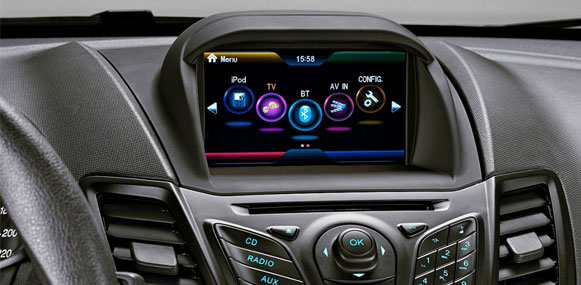Sustainability Report 2013/14
Vehicle Safety and Driver Assist Technologies
Case Study: Driver Distraction
Smart phones and other portable electronic devices (e.g., MP3 music players) are commonplace in our modern society. The public has become accustomed to using these devices everywhere – at home, on the street, in restaurants, at the office, while shopping, and – of most interest to Ford’s safety researchers – while driving. Indeed, studies by the National Highway Traffic Safety Administration indicate that approximately 10 percent of drivers are using their cell phones at any given time, which has heightened concerns about the potential for driver distraction.
Ford agrees that this is an important safety issue, and we have taken steps to address it. We also believe that continued research is needed to better understand the complex interactions involved in this issue, and we are participating in that research.
Some entities have recommended a total ban on the use of cell phones – both hand-held and hands-free – while driving, citing studies that concluded there’s no difference in driver behavior whether using hand-held or hands-free phones. In many of those laboratory studies, participants in simulated driving situations were observed while being asked to engage in in-depth conversations on challenging or emotional subjects, such as the latest political scandal or a near-death experience. Such intense and lengthy discussions can indeed be distracting.
Naturalistic driving studies – in which study participants’ driving performance, “eye glance behavior,” driving environment and in-vehicle activities are observed and recorded over weeks or months in real-world situations – have revealed different results. For example, naturalistic studies by the University of Michigan Transportation Research Institute found that, when immersed in real traffic conditions, drivers using cell phones by and large exhibit prudent driving behavior.
Naturalistic driving research has found that visual distraction, not cognitive distraction, is the main safety concern in the real world. In fact, researchers from the Virginia Tech Transportation Institute (VTTI) found that 80 percent of all crashes, and 65 percent of all near-crashes, involved the driver looking away from the forward roadway just prior to the onset of the incident. These researchers summarized their findings in this way: “... it is a rare case that a crash occurs while the driver’s eyes are on the forward roadway, regardless of any other ‘cognitive demand’ that they might be engaged in.”
Beyond this, there exists a considerable body of published research that indicates the superiority of hands-free voice interfaces as compared to hand-held or visual/manual interfaces for the same tasks of command or data entry. These studies show advantages in driver performance, eye glance behavior toward the roadway, and object and event detection when the driver can keep eyes on the road and hands on the wheel.
For over a decade, Ford has been focused on the issue of driver distraction, and we’ve taken steps to enhance driving safety for those who use cell phones and other telematics devices while driving.

Ford SYNC®
Ford’s SYNC® technology, our voice-activated in-car connectivity system, has been shown to significantly enhance the ability of drivers to attend to the driving task while using cell phones and music players. Ford researchers found that SYNC substantially reduces drivers’ eyes-off-road time and improves lane-keeping, speed maintenance, and object and event detection response times, when compared to hand-held devices for the same tasks. Our research evaluated driver performance, not driver behavior in the real world, and our findings are consistent with the research conducted by VTTI, which we believe indicates that SYNC helps to enhance highway safety overall.
Ford recognizes that drivers will in fact use cell phones and music players while driving, and that text messaging will continue to increase in popularity. Text messaging is a particular concern, as it requires significant time looking away from the roadway to do it. Ford’s SYNC system addresses this concern as well: when a text message arrives, it does not display that message but instead reads it aloud through text-to-speech technology. In addition, SYNC allows the driver to potentially respond via speech-to-text rather than manually keying-in a reply.
We believe that ongoing education is needed to help drivers understand the importance of focusing on the driving task and keeping their hands on the wheel and eyes on the road. Ford plans to continue to work with the government and other safety-related groups to discuss measures that can effectively reduce driver distraction and improve driving safety. We also plan to participate in continued research that can further our understanding of safe driving and help spread the message of safe driving.
Related links
External Websites
© 2014 Ford Motor Company